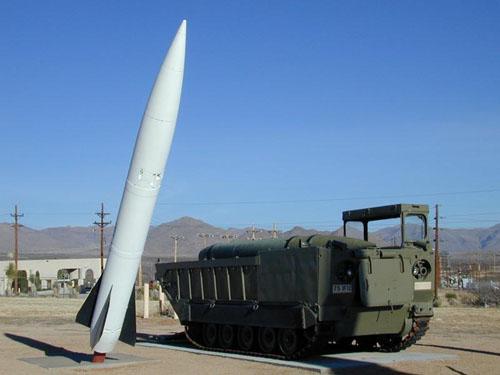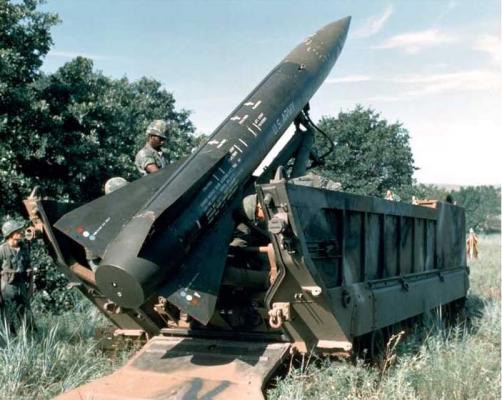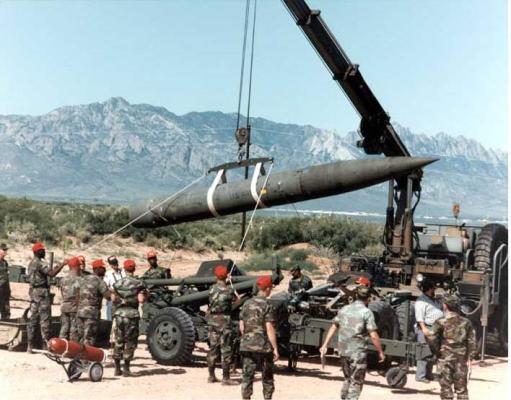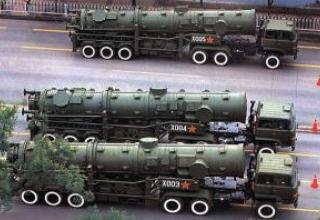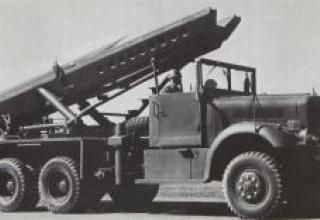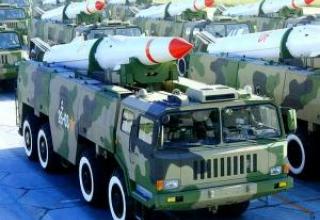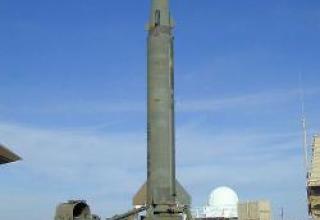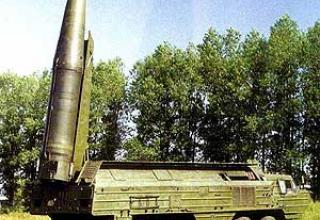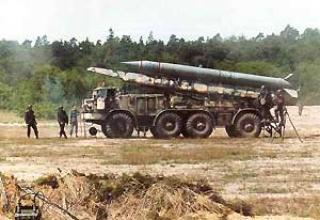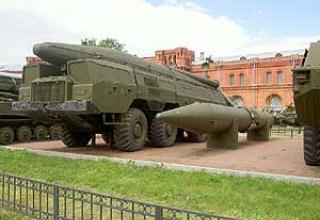In 1962, research work began on the Lance missile system. The company Ling-Temco Vote was chosen as the leading developer. At first, it was envisaged that the Lance missile would have a range of about 50 km. Tests of the main series missiles of this range were started in mid-1964. However, in 1966, at the initiative of the U.S. Army Command in parallel began to develop a missile "Lance" XRL, which has a longer range. While the first version of the Lance missile was intended to replace the ONEST John missile, the second version was also intended to replace the Sergeant missile. By that time, serious difficulties had emerged in developing a fuel supply system for the engine of the original Lance rocket. Therefore, in December 1967, the U.S. Secretary of Defense decided to stop the development of the Lance missile of the first version and continue work on the second.
Specialists of the firm "Ling-Temco Vote", describing the missile system "Lance", noted its high reliability and low cost. They point out that the "Lance" missile can be used in any climatic conditions in which infantry, tank, mechanized or airborne divisions can fight.
Composition:
The Lance missile system consists of the following combat vehicles:
- Lance rocket XMG-M52C
- Self-propelled launcher XM752
- Transport Charger XM688E1
- Lightweight wheeled launcher XM740
- Wheel Chassis XM234
- Missile sighting equipment
- Remote starter XM91E1
- Lifting traverse for XM22E1 missile
- Program Verification Block AN/JM-24
- Trenoga to lift the rocket XM28E1.
All elements of the system are air transportable, the vehicles of the complex have high mobility. Mobility, reliability and invulnerability to electronic countermeasures give the Lance missile system the combat qualities it needs to directly support highly mobile military units. In terms of effectiveness, one division of such missiles is equivalent to three divisions of ONEST John or Sarge missiles.
Lance missile XMG-M52C
Lance" rocket XMG-M52C - ballistic, short-range operational-tactical missile. The range varies from 5 to 120 km, depending on the combat mission and the type of combat unit: with conventional warheads - 70-80 km, and with nuclear warheads - 110-120 km. The delivered payload mass: conventional combat unit - 454 kg; nuclear - 211 kg. Starting mass with conventional combat unit - 1520 kg; with nuclear combat unit - 1285.47 kg. The "Lance" missile can carry: the XM 234 nuclear warhead with the capacity of 1-10 kt, the XM 188 head unit with ordinary explosive substance, the XM-251 cassette missile with armor-piercing and fragmentation elements (850 pieces); the TGSM cassette missile with homing submunitions. The combat unit has no separation system, i.e. it is not separated from the missile.
Fuel tanks. Fuel tanks are cylindrical, carrying, they are placed in series. After refueling, the tanks are sealed and sealed. The front tank (fuel tank) contains asymmetric dimethylhydrazine, in the rear tank (oxidizer tank) - red smoky nitric acid. The fuel components are separated by an intermediate bottom. This design ensures long storage of the missile in the fueled state and safe operation. Each tank has plate pistons. There are plate pistons in the centre of the oxidizer tank. In the centre of the oxidizer tank, a fuel pipeline runs through the piston. There is a gas generator on the axis of the fuel tank and the piston slides on its body as it moves. After the powder charge of the gas generator has ignited, the resulting hot gases fill the piston spaces in the fuel and oxidizer tanks. Under the influence of gas pistons press on fuel components. The latter break through the sealing membranes and enter the engine, where they self-ignition. The pistons have special seals that prevent the gas from connecting to the fuel components.
Fuel: Symmetrical dimethylhydrazine is a colourless transparent liquid with gyroscopic properties and a pungent odour. Compared to hydrazine, it has a lower efficiency as a fuel. Compared to hydrazine, however, it is easier to use because it remains liquid over a longer temperature range. It has good resistance to heat. NDMG is chemically active and easily oxidized by oxygen. At storage should not come into contact with air In relation to metals pure NDMG is not aggressive and allows long storage in tanks. However, the presence of water leads to corrosion of aluminum and its alloys. NDMH is very toxic; it causes damage to the lungs, liver and blood components. Boiling point - +63, hardening temperature -57, specific weight - 0.79 *103 kg/m3.
Oxidizer: Nitric acid is a colorless heavy liquid that smokes strongly in the air. Nitric acid is a powerful oxidizer, as it contains 76% oxygen. It has a high specific gravity. Due to its high heat capacity, it can be used as a cooling component of the liquid chamber. The main drawback of nitric acid is its high corrosivity in relation to most materials. As a result of corrosion, the metal in the storage tank is corroded and a gelatinous sludge is formed at the bottom which can clog the pipelines. Aluminium and its alloys, stainless chromium and chromium-nickel high-alloy steels can be used as structural materials for storage of nitric acid. Boiling point is +86, hardening temperature is -42, specific weight is 1.53 *103 kg/m3.

The engine. The engine of the "Lance" rocket has two cameras: a marching chamber and a launch chamber (the first inside the second). At the initial section of the trajectory both chambers operate (acceleration phase). When reaching a given speed of the rocket two pyrotechnic valves are triggered, fuel and oxidizer supply to the launch chamber is stopped, and it turns off. The launch chamber is also called the "five-ring" engine, as it has five ring manifolds for fuel supply (three for an oxidizer, two for fuel). The traction of the engine's escape chamber can vary from maximum to zero when the missile is flying.
Feeding system. Fuel supply system (power plant) is used to supply fuel components in the chamber. The Lance XMG-M52C uses a displacement fuel supply system. The advantage of the displacement system over the discharge system is that it (the displacement system) has a lower total weight and is more compact than the discharge system. The fuel supply system consists of a solid fuel gas generator, start-up and shut-off valves, diaphragms and other devices. A gaseous working body is inserted into the piston spaces of the tanks above the fuel level, which is produced by the gas generator (the tanks are inflated). By applying pressure to the pistons, the gas displaces the components from the tanks. In the centre of the oxidiser tank, a pipeline of fuel runs through the pistons. The gas generator is located on the axis of the fuel tank and the piston slides on its housing as it moves. The pistons have special seals that prevent the gas from connecting to the fuel components. The increased pressure in the fuel tanks allows to avoid caving, as well as to unload the thin-walled shell of the tanks, on which in flight the compressive forces caused by the counter air flow. Stability of operation of the WDF is provided by regulators, which maintain the required value of traction characteristics.
The control system was developed especially for the Lance missile. At the time the missile was adopted, it was invulnerable to all known electronic countermeasures. The Lance missile control system AN/DJW-48 (XO-1) is a simplified inertial. It consists of subsystems, the main ones being the Direction and Speed Control Machine (DC), the Weather Compensation Machine (Automet) and power supplies. Also included in the control system is a rocket launcher, which serves to give longitudinal stability (roll stabilization loop). The device for unwinding the missile is in the plane of its centre of gravity (see diagram in item 2).
Nozzles device unwind the rocket during the first 1.5 seconds after the launch of the rocket. Later on, the missile rotation is supported by four sloping tail stabilizers. The direction and speed of the missile's flight with the DC subsystem is controlled at the starting point during the launch chamber operation. A gyroscopic method is used to hold the missile in a given direction when aiming at the DC subsystem. During the launch chamber operation the given position of the rocket is maintained by means of four control valves of "open-close" type of the traction vector control system located at an angle of 90o around the circle in the critical part of the nozzle of the engine's launch chamber.
Similar to the rudders, which correct for deviations in the direction of missile flight, the valves on command from the DC subsystem control fuel injection into the critical part of the nozzle of the launch chamber, resulting in lateral forces that change the direction of the thrust vector. This in turn leads to a change in the missile's movement in the angles of pitch and yaw. The engine's launch chamber operates for 1.5-6 seconds. It is switched off on command from the accelerometer when the missile's speed reaches a preset value. After that, the flight of the rocket and the work of the engine escape chamber is controlled by a subsystem Automet ("Automet"). The flight chamber is regulated in such a way that at each moment its thrust is equal to the force of frontal resistance acting on the missile. The traction varies from maximum to zero. During the missile's flight, the Automet subsystem automatically compensates for the effects of wind, air density changes and other weather factors. Power sources provide power to the instruments on board the missile. The rocket's power supply subsystem consists of two batteries and an electronic power distribution unit. The control system compartment also contains a temporary mechanism. It commands the triggering of a pyrotechnic valve that stops the gas supply to the rocket launcher.
Depending on the type of head unit used, two types of stabilizers are used in the missile. Large honeycomb stabilisers made of aluminium are used when launching nuclear-powered missiles, while smaller aluminium stabilisers are used when launching missiles with heavy non-nuclear heads. The weight of the first ones is 34.7 kg, the second ones are 28.8 kg.
Self-propelled launcher.
Self-propelled launcher highly mobile, floating. It is based on the XM667E1 tracked conveyor.
Weight of the launcher with a rocket equipped with a nuclear head unit is 9075 kg, and with a non-nuclear head unit is 9298.19 kg. The length of the launcher is 6,568 m, width is 2,709 m, height on the body is 2,279 m, on the cabin is 2,715 m. Engine is 6V53 diesel. In the body of the unit is mounted the starter, which is an integral part of it. However, it can be removed and installed on a wheeled chassis.
In this way, the lightweight, towed launcher is mounted. The speed of the self-propelled launcher is 64 km/h on the highway and up to 10 km/h on water. Temperature range of the unit operational use is from -40 to +60 0C.
Transport-charging machine
The transport - charging machine is designed to deliver missiles to the launcher and its equipment. It is based on the XM667E1 tracked transporter. The body of the conveyor is equipped with a tray for two missiles, it is mounted crane and accommodates the necessary auxiliary equipment. The drive of the crane is hydraulic.
Auxiliary equipment located on the transport and charging machine includes equipment for checking the rocket, a cover for the body of the machine, various accessories and tools. The transport and charging machine, like the self-propelled unit, can be transported by air and dropped by parachute.
Towed launcher
The towed launcher is a launcher mounted on a two wheeled chassis. The length of the launcher without a rocket 6,413 m, width 1,981 m, height without a rocket 1,756 m. There are horizon jacks and other devices on the chassis. The lightweight launcher is towed by a standard 2.2-ton M35 type vehicle. If necessary, the launcher can be mounted on the wheeled chassis of the XM234 in the field. For this purpose, the launcher is removed from the self-propelled launcher. Manual actuators are used to point the missile at the launcher. Before and after the launch (at the starting point of the guided motion), the missile is held in the launcher by grips and a swivel bungee. After the missile has moved 127 mm along the guide rail of the launcher, the grippers release the tail part and the swivel bungee is discarded.
Start up control equipment
Before taking up the starting position, the topogeodesic preparation for firing is carried out. After taking up position, the Lance rocket is guided to the target by the manual triggering device. A special sighting device and a mirror attachment with a standard army theodolite kit are also used for pointing. The sights are used to give the missile the required elevation angle (after azimuth guidance).
For the prelaunch preparation of the rocket "Lance" XMG-M52C designed software and check unit AN / GJM-24. Included in it analog-to-digital computer on solid elements is used to configure the missile control system in accordance with the useful task, check the nodes and elements of the missile and automatic prelaunch operations. The verification and launch equipment is powered by a 24-volt battery consisting of nickel cadmium cells.
During prelaunch preparation, the software and test unit controls the readiness of the missile and prevents the shutdown of the safety system and the launch of the missile if the indicators on the panel of the unit show that the missile is faulty. Prelaunch operations start after pressing two buttons (disarming the safety and launching) on the remote control. For the missile launch, the remote control is located 100 m away from the launcher.
When the launch button is pressed, the on-board thermochemical batteries are activated according to the commands of the software and verification unit, the gyroscope is rotated to the required speed and the head unit electronics are switched on. When the confirmation of these operations is received by the software and test unit, the command to start the propulsion system is issued and the missile is launched.
Characteristics:
| Lance missile system | |
| Year of adoption | 1972 |
| Place of development | US |
| Company Designer | LTV (Ling-Temco Vot) |
| Lance XMG-M52C" rocket | |
| Number of steps, pcs. | 1 |
| Head Unit (HU) | No |
| Maximum diameter, m | 0,557 |
| Length, m | 6,146 |
| Launch weight of the rocket with nuclear HF, kg | 1285,47 |
| Launch weight of the rocket with non-nuclear HF, kg | 1520 |
| Firing range with nuclear HM 234, km | 110-120 |
| Range of fire with non-nuclear HF, km. | 70-80 |
| Maximum height of the trajectory, km | 45720 |
| It's flight time, s | 200 |
| Length HF, m | 2,46 |
| Nuclear-charged HF mass, kg | 211 |
| Non-nuclear HF mass, kg | 454 |
| XM234 nuclear HF power, kt. | 1-10 |
| Number of armour-piercing shrapnel elements of cassette HF XM-251, pcs. | 850 |
| XM234 nuclear HF power, kt. | 1-10 |
| Motor type | WRD |
| Fuel | asymmetric dimethylhydrazine |
| Weight of fuel, kg | 170,37 |
| Oxidizer | inhibited red smoky nitric acid |
| Mass of oxidizer, kg | 502,13 |
| Delivery System | preemptive |
| Number of combustion chambers, pcs. | Two, marching inside the launch pad. |
| Starting COP operating time, s | 1,5-6 |
| Control System | AN/DJW-48 (XO-1), simplified inertial |
| Control System Composition | -Direction and Speed Control (DC) Machine -meteorological compensation machine (Automet) |
| Traction Vector Control | fuel injection |
| Self-propelled launcher XM752 | |
| Base | tracked conveyor XM667E1 |
| Weight, kg | 7789,53 |
| Length, m | 6,568 |
| Width, m | 2,709 |
| Cabin height, m | 2,715 |
| Body height, m | 2,279 |
| Engine | diesel, 6V53 |
| Highway speed, km/h. | 64 |
| Speed on water, km/h. | 10 |
| Temperature range, 0C | -40 - +60 |
| Transport Charger XM688E1 | |
| Base | tracked conveyor XM667E1 |
| Weight, kg | 8120,69 |
| Hoisting crane drive | hydraulic |
| Transmission machine | XM688E1 |
| Towed launcher | |
| Base | two-wheeled chassis |
| Weight, kg | 1769,02 |
| Length, m | 6,413 |
| Width, m | 1,981 |
| Height, m | 1,753 |
Testing:
The first flight test of the XMG-M52C "Lance" rocket with extended range was conducted at White Sands Range on March 6, 1969. The first series of missiles entered the army for military trials in April 1971. The first launch took place in August 1972, and in March 1972 the military trials were fully completed.
In May 1972, the missile system "Lance" was officially recognized as a protocol model of military equipment and was classified as a class "Standard A". However, only a Lance missile with a nuclear warhead was included in this class, as Congress had not yet approved the development of a cluster bomb head unit, which the command of the ground forces considered necessary to have in service.
Immediately after the approval of the missile, the delivery of the Lance missile system to NATO partners and Israel began. Six divisions were formed in Europe. Two of them were in Germany, which could not but bother the USSR Armed Forces group "Center": the flight time of the Lance missile is only about 200 seconds, so there was no way to quickly detect and shoot down the missile. Missiles equipped with non-nuclear head units were delivered to Israel.
There are reports that the Lance missile system was used by U.S. forces during the war in Afghanistan in the late 70's and early 80's.
In the mid-80s, the Lance missile system was withdrawn from service due to the nuclear arms reduction treaty between the USSR and the United States. Currently, the Lance missile is used as a target for anti-missile testing. There is evidence that it is used in the development of the US national missile defense program.
Sources:
- "Ракетная система "Lance"", Зарубежное военное обозрение, 1974 г., №1
- "Ракетный комплекс "Lance"", Техника вооружения за рубежом, 1975 г., №2
- "Оперативно-тактический ракетный комплекс "Lance" на вооружении израильской армии",Armis and Weapons, 1976 г., №20,36
- http://www.manuelsweb.com
- http://www.redstone.army.mil/history/lance/welcome.html
